American Sign Language (ASL) is a visual-gestural language used by members of the Deaf community in the United States and Canada. It is a complete language, with its own unique grammar, syntax, and vocabulary, and is not simply a visual representation of English. ASL is used to communicate through the use of hand gestures, facial expressions, and body language, and is a rich and vibrant language that has a long and fascinating history. In this blog post, we will explore what ASL is, its importance to the Deaf community, American Sign Language interpreting services, and the benefits of learning and using ASL in everyday life.
American Sign Language is a “Young” Language
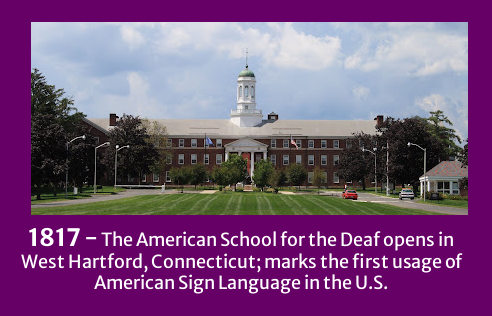
Although deaf people have always used gestures and body language to communicate, it was not until the establishment of schools for the deaf that a standardized sign language was developed. The first school for the deaf in the US was founded in 1817 in West Hartford, Connecticut, and it was here that the roots of today’s ASL began to take shape. Educators and students alike began to develop a visual language that could be used to communicate with one another and, over time, this language evolved into the rich and complex language that is used today.
Why Is the Deaf Community (Still) Underserved?
No one knows exactly how many people need ASL services because the last time the U.S. Census Survey questionnaire included “deaf” was in 1930. In 2016, The National Library of Medicine published a study concluding an estimated 2.2 million U.S. residents 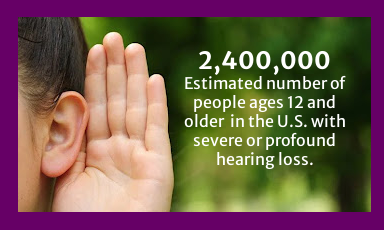 aged 12 or older had severe or profound hearing loss. Based on the increase of the U.S. population in the years since 2016, today’s number is likely closer to 2.4 million.
aged 12 or older had severe or profound hearing loss. Based on the increase of the U.S. population in the years since 2016, today’s number is likely closer to 2.4 million.
This makes hearing loss the third most common chronic physical condition in the U.S. — twice as prevalent as diabetes or cancer.
So, why are deaf and hard-of-hearing people still underserved? One important reason: 98% of them do not receive education via sign language.
ASL and the Americans with Disabilities Act (ADA)
The ADA Requirements for Effective Communication specify a “qualified sign language interpreter” or devices such as real time closed-captioning be provided in “state and government services” and “public accommodations and commercial facilities.” This requirement includes both public and private schools, along with many other organizations and businesses. Those who do not comply are in danger of heavy fines and civil lawsuits. And yet, many deaf and hard-of-hearing students do not receive the assistance they are entitled to.
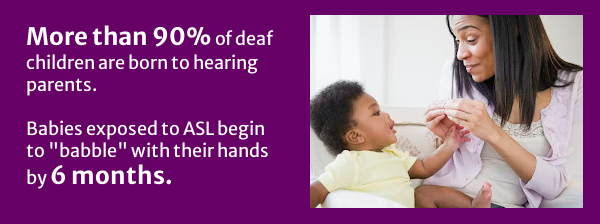 Moreover, the importance of the education that children receive before reaching public school age has a profound impact on their future success. According to the National Institute on Deafness and Other Hearing Disorders, more than 90% of deaf children are born to hearing parents, and 72% of families do not sign with their deaf children.
Moreover, the importance of the education that children receive before reaching public school age has a profound impact on their future success. According to the National Institute on Deafness and Other Hearing Disorders, more than 90% of deaf children are born to hearing parents, and 72% of families do not sign with their deaf children.
If child-caregiver communication is nonexistent within the first five years of the child’s life, they are at risk to suffer from “language deprivation,” which can have an enormous negative effects that manifest later in life.
The Consequences of Language Deprivation
Children with hearing loss are more likely to suffer academically than their hearing peers. Up to 50% of classroom discussion is likely to be missed in classes conducted without ASL.
 Deaf people are:
Deaf people are:
- 26.3% more likely to have a “less than high school” education than hearing people.
- 21.3% less likely to graduate high school.
- 15% less likely to obtain a bachelor’s degree
This disparity in education has consequences that continue well beyond the classroom. An early education gap often translates into an income gap later in life.
Here are some more eye-opeining figures (from Communication Services for the Deaf):
- 70% of deaf people are unemployed or underemployed.
- Only 40% of people with a hearing disability are employed full time.
- 25% of deaf people report having left a job due to discrimination.
- 1 in 4 deaf women will be sexually assaulted (national average for hearing women is 1 in 10).
The Impact of ASL Interpreting on Health
According to the National Technical Institute for the Deaf, deaf individuals are up to seven times as likely as their hearing peers to have heart disease, high blood pressure, and strokes. Anxiety and depression are also present in much higher numbers in these communities. The Journal of Health Communications asserts that many deaf and hard-of-hearing patients have inadequate health literacy, contributing to these issues.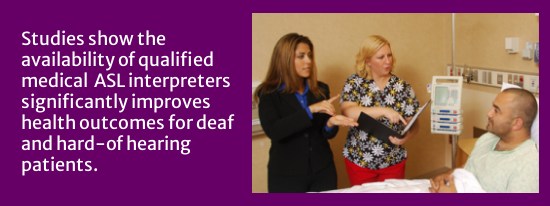
Research studies indicate that the availability of qualified medical ASL interpreters significantly improves health outcomes for the deaf and hard-of hearing. Like schools, healthcare providers are required by federal law to provide interpreters and other methods to allow them to communicate with the deaf patient, and even to deaf family members who accompany the patient. If you or a family member is deaf or hard-of-hearing, whenever possible choose a healthcare provider who includes ASL as part of a language access program for their patients.
The Difference Professional ASL Interpreters Can Make
Fluency in American Sign Language does not make an individual qualified to interpret for others. Interpreting is a highly specialized profession, requiring knowledge of both language and interpreting skills. Additionally, professional interpreters who work in the field of healthcare are required to adhere to a code of ethics as determined by National Council on Interpreting in Health Care (NCHIC).
For Certified Medical ASL Interpreters, requirements are even more rigorous, and include 100 hours of training. “Ad-hoc” medical interpreters have been shown to have a typical error rate of more than 22% – a statistic that can lead to dire consequences for patients and enormous liabilities for healthcare organizations. In contrast, professional medical interpreters who have completed 100 hours of training have an error rate of 2% or less.
iTi’s ASL Services
At Interpreters and Translators, Inc., our contracted ASL interpreters are available for in-person assignments, especially in New England. Additionally, ASL interpreters can be accessed 24/7/365 via our Video Remote Interpreting service. These services have been extremely valuable to our partners in healthcare, education, government, business and the legal community. Want to learn more about ASL? Check out our related content “How to Get The Most Out of Your ASL Interpreting Session“.
iTi is ready to help with your ASL interpreting needs. Contact us today using the link below, or give us a call at 860.968.6777.
| Contact Us |






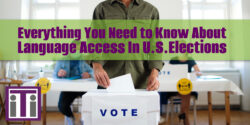
Comments are closed here.